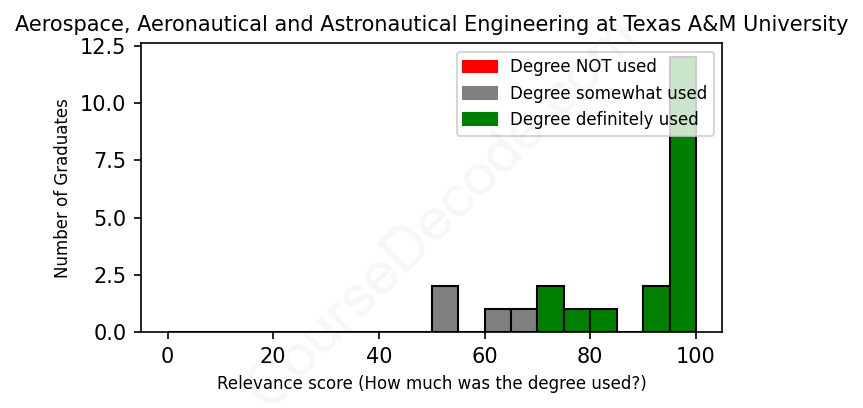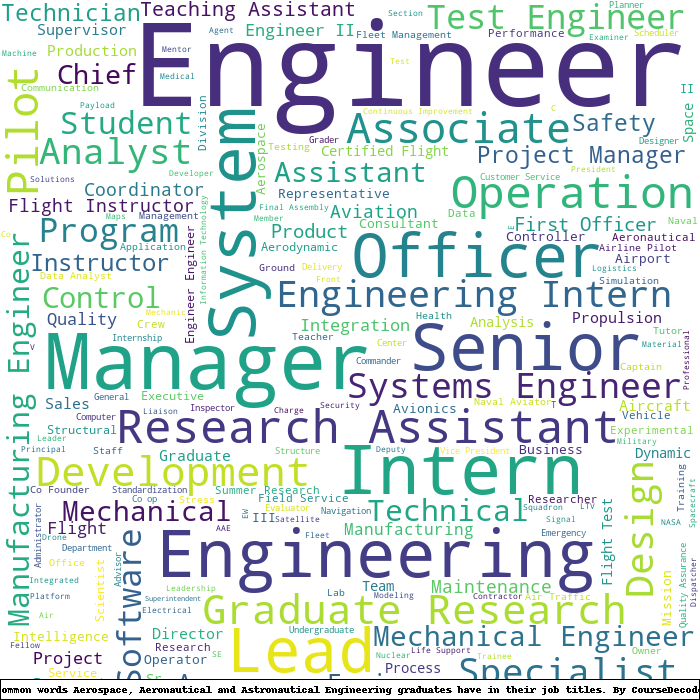
First, some facts. Of the Aerospace, Aeronautical and Astronautical Engineering graduates from Texas A&M University we've analyzed , here's how many have used (or NOT used) their degree in their career:

These are estimates based on AI analysis of 22 LinkedIn profiles (see below).
The verdict? Significantly above average. Overall, with an average relevance score of 87%, Aerospace, Aeronautical and Astronautical Engineering graduates from Texas A&M University have a much higher likelihood (+20%) of finding work in this field compared to the average graduate across all fields:
And for comparison, here's the chart for all profiles we've looked at across all degrees.
Also, after graduating, only 22% of these graduates have pursued further education other than another Bachelor's degree (such as a Masters degree or other), compared to the average across all profiles of 35%. This suggests a Bachelors degree is enough for most Aerospace, Aeronautical and Astronautical Engineering graduates, and it's normal to look for work straight after graduation.
See the details:
|
Relevance score: 74% We think this person has gone into a career highly relevant to their degree. We think this person has gone into a career highly relevant to their degree.
DEGREE INFOGraduated in 2012 from Texas A&M University with a Bachelor of Science (BS) in Aerospace, Aeronautical and Astronautical Engineering. No other secondary education since. JOB HISTORY SINCE GRADUATIONAsset Integrity Analyst Pinnacle Jan 2013 - Dec 2013 Project Lead  Pinnacle Dec 2013 - Sep 2015 Corrosion Specialist  Pinnacle Sep 2015 - Jan 2019 Lead Corrosion Engineer  Pinnacle Jan 2019 - Jun 2023 RBI Engineer  Chevron Jun 2023 - Present ABOUTCorrosion and materials engineer with 10 years of experience in the refining and chemical industries. Support numerous accounts and projects across the globe identifying potential degradation mechanisms and developing corrosion models. Developed Integrity Operating Windows to ensure mechanical integrity, written Corrosion Control Documents, and been published in Inspectioneering. Function as a technical expert for all projects at my current employer and am the Technical Excellence Owner of the largest account. Previously, I was a project lead where I managed a team of engineers and technicians, ensured execution and quality of all aspects of multiple mechanical integrity implementation projects, and functioned as the face of the company in correspondence with our clients. |
The top 10 most common jobs done by the graduates we've analyzed (ranked most common to least) are:
From analyzing the job placements of Texas A&M University graduates with degrees in Aerospace, Aeronautical, and Astronautical Engineering, it's pretty clear that a variety of roles exist in this field. Many graduates have found positions that directly relate to their studies, particularly with companies like Lockheed Martin, Collins Aerospace, and other industry giants. Common titles include system engineers, aeronautical engineers, and roles specific to aerospace operations, which typically require the technical knowledge learned during their studies. Positions like Flight Controllers and Aerospace Engineers at organizations like NASA and various private aerospace companies are prime examples of jobs highly aligned with their educational background.
However, it's important to note that not all roles fell squarely within the realm of aerospace engineering. Some graduates ended up in positions that, while utilizing analytical or engineering skills, do not primarily focus on aerospace principles. Jobs like Electric Distribution Engineer, Quality Engineer, and various project management roles had varying degrees of relevance. While some skills from their education can be applied, they often don’t use specific aerospace knowledge daily. Overall, while many graduates do find jobs closely related to their degree, there’s a notable mix, and not everyone is working in a role that directly leverages the specialized knowledge they gained in aerospace engineering.
Here is a visual representation of the most common words in job titles for Aerospace, Aeronautical and Astronautical Engineering graduates (this is across all Aerospace, Aeronautical and Astronautical Engineering graduates we've analyzed, not just those who went to Texas A&M University):

Graduates from Texas A&M University's Aerospace, Aeronautical, and Astronautical Engineering program seem to have quite promising career trajectories. Many of them land roles in reputable companies and organizations relevant to their field right after graduation. For instance, a good number have started as engineers or analysts in companies like Collins Aerospace, Lockheed Martin, and various aerospace research initiatives. It appears that the first jobs for many graduates are typically centered around system engineering, project management, or specialized roles such as flight controllers and research engineers. This gives them a solid foundation in aerospace engineering and helps them establish valuable industry connections.
Five to ten years later, many of these graduates continue to thrive in their careers. They often move into more advanced positions like lead engineers, project leads, or specialized roles within their organizations, including significant responsibilities on projects for NASA or major aerospace contractors. However, there are also some who have branched out into unrelated fields, like a couple of graduates who transitioned into teaching or software development outside of aerospace. Overall, it seems that a majority of Texas A&M aerospace graduates find meaningful and relevant careers that align well with their studies, leading to sustained growth in the aerospace sector or related industries.
Getting a Bachelor’s degree in Aerospace, Aeronautical, and Astronautical Engineering is definitely on the challenging side, especially at a school like Texas A&M University known for its rigorous programs. You'll be diving deep into complex subjects like fluid dynamics, propulsion systems, and materials science, which can be pretty tough if you're not super strong in math and physics. The coursework is intense, with a lot of group projects and hands-on labs that require teamwork and innovation. So, while it’s not impossible, you should be prepared to put in a serious amount of effort, study time, and probably some late nights to keep up with everything. If you’re passionate about the field, though, the challenge can be really rewarding!
Most commonly, in the LinkedIn profiles we've looked at, it takes people 4 years to finish a Bachelor degree in Aerospace, Aeronautical and Astronautical Engineering.
Looking at these Texas A&M grads in aerospace and related fields, it seems like most of them have found some solid job opportunities and are doing pretty well financially. Many of them are working at big names like Lockheed Martin, NASA, and Boeing, which typically pay well, especially for engineers. It’s also cool to see some of them moving up the ranks quickly, with positions like lead engineers and specialists after just a few years. The ones who started as interns or research assistants are also paving their way into decent roles, which is a good sign. Overall, while it’s tough to say exact figures without salary data, it definitely looks like they have a good shot at making decent money in aerospace!
Here is a visual representation of the most common words seen in the "about" section of LinkedIn profiles who have a Bachelor degree in Aerospace, Aeronautical and Astronautical Engineering (this is across all Aerospace, Aeronautical and Astronautical Engineering graduates we've analyzed, not just those who went to Texas A&M University). This may or may not be useful:

Here are all colleges offering a Bachelor degree in Aerospace, Aeronautical and Astronautical Engineering (ordered by the average relevance score of their Aerospace, Aeronautical and Astronautical Engineering graduates, best to worst) where we have analyzed at least 10 of their graduates:
| College | Score | Count |
|---|---|---|
 Texas A&M University Texas A&M University
|
87 | 22 |
 California Polytechnic State University-San Luis Obispo California Polytechnic State University-San Luis Obispo
|
86 | 12 |
 University of Cincinnati University of Cincinnati
|
86 | 10 |
 Purdue University Purdue University
|
85 | 40 |
 Rensselaer Polytechnic Institute Rensselaer Polytechnic Institute
|
85 | 17 |
 Georgia Institute of Technology Georgia Institute of Technology
|
84 | 23 |
 Liberty University Liberty University
|
81 | 21 |
 Iowa State University Iowa State University
|
80 | 16 |
 University of Colorado Boulder University of Colorado Boulder
|
80 | 13 |
 California State Polytechnic University-Pomona California State Polytechnic University-Pomona
|
79 | 13 |
 United States Naval Academy United States Naval Academy
|
77 | 12 |
 The Ohio State University The Ohio State University
|
76 | 20 |
 University of Central Florida University of Central Florida
|
75 | 25 |
 Arizona State University Arizona State University
|
74 | 12 |
 University of Michigan University of Michigan
|
74 | 10 |
 Embry-Riddle Aeronautical University Embry-Riddle Aeronautical University
|
71 | 163 |
 Penn State University Penn State University
|
68 | 12 |
 Florida Institute of Technology Florida Institute of Technology
|
67 | 20 |
 The University of Alabama in Huntsville The University of Alabama in Huntsville
|
67 | 11 |
 Embry Riddle Aeronautical University-Worldwide Embry Riddle Aeronautical University-Worldwide
|
66 | 10 |
 University of Illinois at Urbana-Champaign University of Illinois at Urbana-Champaign
|
48 | 10 |